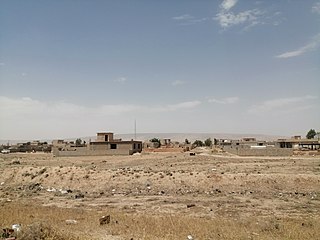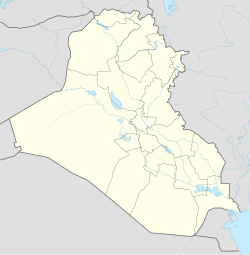
Sinjar is a town in the Sinjar District of the Nineveh Governorate in northern Iraq. It is located about five kilometers south of the Sinjar Mountains. Its population in 2013 was estimated at 88,023, and is predominantly Yazidi.

Til Ezer is a village located in the Sinjar District of the Ninawa Governorate in Iraq. The village is located south of the Sinjar Mount, in the disputed territories of Northern Iraq.

The Sinjar District or the Shingal District is a district of the Nineveh Governorate. The district seat is the town of Sinjar. The district has two subdistricts, al-Shemal and al-Qayrawan. The district is one of two major population centers for Yazidis, the other being Shekhan District.

Baadre (also written Ba'adra, Badra or Bathra, is a town located in the Shekhan District of the Ninawa Governorate in northern Iraq. The town is located in the Nineveh Plains. It belongs to the disputed territories of Northern Iraq. According to 2014 statistics, Baadre's urban population was 9 835 and the rural population was 5 167.

The Sinjar massacre marked the beginning of the genocide of Yazidis by ISIL, the killing and abduction of thousands of Yazidi men, women and children. It took place in August 2014 in Sinjar city and Sinjar District in Iraq's Nineveh Governorate and was perpetrated by the Islamic State of Iraq and the Levant (ISIL). The massacre began with ISIL attacking and capturing Sinjar and neighboring towns on 3 August, during its Northern Iraq offensive.
Between 1 and 15 August 2014, the Islamic State of Iraq and the Levant (ISIL) expanded territory in northern Iraq under their control. In the region north and west from Mosul, the Islamic State conquered Zumar, Sinjar, Wana, Mosul Dam, Qaraqosh, Tel Keppe, Batnaya and Kocho, and in the region south and east of Mosul the towns Bakhdida, Karamlish, Bartella and Makhmour
The condition of human rights in the territory controlled by the Islamic State (IS) is considered to be among the worst in the world. The Islamic State's policies included acts of genocide, torture and slavery. The United Nations Commission on Human Rights (UNCHR) stated in November 2014 that the Islamic State "seeks to subjugate civilians under its control and dominate every aspect of their lives through terror, indoctrination, and the provision of services to those who obey". Many Islamic State actions of extreme criminality, terror, recruitment and other activities have been documented in the Middle East.

The Sinjar offensive was a combination of operations of Kurdish Peshmerga, PKK and People's Protection Units forces in December 2014, to recapture regions formerly lost to the Islamic State of Iraq and the Levant in their August offensive.

The November Sinjar offensive was a combination of operations of Kurdish Peshmerga, PKK, and Yezidi Kurd militias in November 2015, to recapture the city of Sinjar from the Islamic State of Iraq and the Levant. It resulted in a decisive victory for the Kurdish forces, who expelled the ISIL militants from Sinjar and regained control of Highway 47, which until then had served as the major supply route between the ISIL strongholds of Raqqa and Mosul.

The Ezidkhan Command for Liberating Sinjar, known as the Sinjar Alliance, is a joint command of two - initially three - Yazidi militias, the Sinjar Resistance Units (YBŞ), and the Êzîdxan Women's Units (YJÊ). Both of the remaining two militias are supported by the Kurdistan Workers' Party (PKK).

The Yazidi genocide was perpetrated by the Islamic State in Iraq and Syria between 2014 and 2017. It was characterized by massacres, genocidal rape, and forced conversions to Islam. The Yazidi people, who are non-Arabs, are indigenous to Kurdistan and adhere to Yazidism, which is an Iranian religion derived from the Indo-Iranian tradition. Over a period of three years, Islamic State militants trafficked thousands of Yazidi women and girls and killed thousands of Yazidi men; the United Nations reported that the Islamic State killed about 5,000 Yazidis and trafficked about 10,800 Yazidi women and girls in a "forced conversion campaign" throughout Iraq. By 2015, upwards of 71% of the global Yazidi population was displaced by the genocide, with most Yazidi refugees having fled to Iraq's Kurdistan Region and Syria's Rojava. The persecution of Yazidis, along with other religious minorities, took place after the Islamic State's Northern Iraq offensive of June 2014.
Qiniyeh is a village in the Sinjar District, south of the Sinjar Mountains in the Nineveh Governorate in Iraq. It is populated by Yazidis and gained international fame in 2014 through the genocide of the Islamic State on the Yazidis.
Siba Sheikh Khidir is a village located in the Sinjar District of the Ninawa Governorate in Iraq. The village is located south of the Sinjar Mount. It belongs to the disputed territories of Northern Iraq. Siba Sheikh Khidir is populated by Yazidis and was one of two villages targeted in the 2007 Yazidi communities bombings against the local Yazidi community.
İsmail Özden, aka Mam Zêki Shingali, was a Yazidi Kurdish member of the Kurdistan Workers' Party, famous for the leading role he played in the resistance to the genocide of Yazidis by ISIL. He was killed on 15 August 2018 in a Turkish Air Force airstrike.
The August 15, 2018, Turkish airstrikes on Sinjar were two airstrikes on İsmail Özden, a leading member of the Sinjar Resistance Units (YBŞ). Four others were killed in the airstrike.

Dohula is a village located in the Sinjar District of the Ninawa Governorate in northern Iraq. The village is located north of the Sinjar Mount. It belongs to the disputed territories of Northern Iraq. It is populated by Yazidis.

Tal Qasab is a village located in the Sinjar District of the Ninawa Governorate in Iraq. The village is located south of the Sinjar Mount. It belongs to the disputed territories of Northern Iraq.
Tal Banat is a village located in the Sinjar District of the Ninawa Governorate in Iraq. The village is located south of the Sinjar Mount. It belongs to the disputed territories of Northern Iraq.
Gir Zerk is a village located in the Sinjar District of the Ninawa Governorate in northern Iraq. The village is located south of the Sinjar Mount. It belongs to the disputed territories of Northern Iraq.

The persecution of Yazidis has been ongoing since at least the 12th century. Yazidis are an endogamous and mostly Kurmanji-speaking minority, indigenous to Kurdistan. The Yazidi religion is regarded as "devil-worship" by Muslims and Islamists. Yazidis have been persecuted by the surrounding Muslims since the medieval ages, most notably by Safavids, Ottomans, neighbouring Muslim Arab and Kurdish tribes and principalities. After the 2014 Sinjar massacre of thousands of Yazidis by ISIL, which started the ethnic, cultural, and religious genocide of the Yazidis in Iraq, Yazidis still face discrimination from the Iraqi government and the Kurdistan Regional Government.












